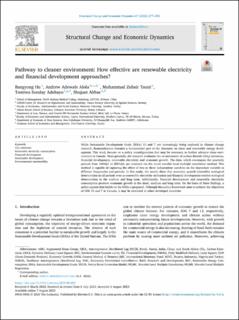Pathway to cleaner environment: How effective are renewable electricity and financial development approaches?
Peer reviewed, Journal article
Published version
Date
2023Metadata
Show full item recordCollections
Original version
Structural Change and Economic Dynamics. 2023, 67 277-292. 10.1016/j.strueco.2023.08.003Abstract
While Sustainable Development Goals (SDGs) 13 and 7 are increasingly being explored in climate change
research, financialization remains a fundamental part of the discourse on clean and renewable energy development. This study focuses on a policy reconfiguration that may be necessary to further advance clean environment in Canada. More precisely, the research evaluates the co-movement of carbon dioxide (CO2) emissions, financial development, renewable electricity and economic growth. The data, which encompass the quarterly periods from 1984Q1 to 2021Q4, are analysed via the novel wavelet local multiple correlation method. This method is capable of capturing the effect of two or three independent variables on the dependant variable at different frequencies and periods. In this study, the results show that economic growth intensifies ecological deterioration in all periods even as renewable electricity utilisation and financial development restrict ecological deterioration in the medium and long term. Additionally, financial development and renewable electricity consumption promote economic growth in the short, medium and long term. On the basis of these findings, a policy agenda that builds on the SDGs is proposed. Although this policy framework aims to achieve the objectives of SDG 13 and 7 in Canada, it may be extended to other developed countries.

